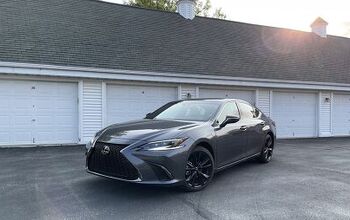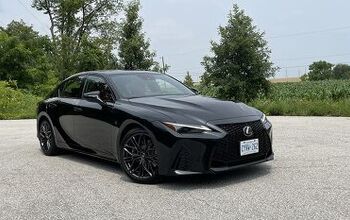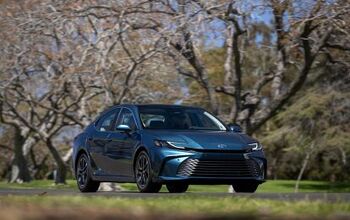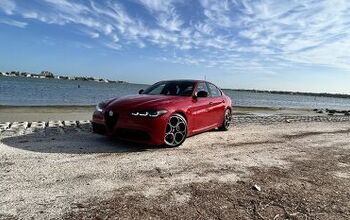2009 Lexus IS F Review
Passion counts. It’s why Porsches win endurance races, Jeeps are good off-road, and Subarus can slide all day long on twisty gravel roads. This is why the teams of performance engineers behind the BMW M3, Audi RS4, and Mercedes-Benz C63 AMG ensure those cars stand alone at the top of the sport sedan totem pole.
FAST FACTS
1. |
Unlike its German rivals, the IS-F can claim to be the fastest model in the fleet. |
| 2. |
The IS-F project was driven by Yukihiko Yaguchi, a man who dreamed of fitting the Lexus V8 in the IS. |
Well, they used to.
ONE MAN’S DREAM
See, all a car company really needs to make a successful performance model is a person who is so totally committed to the task at hand that it consumes him. At Lexus, Yukihiko Yaguchi is that person. He not only found a way to develop a hot version of the IS luxury sedan under the noses of management, but he also found a way to have it powered by a Yamaha-massaged V8 engine from the Lexus LS.
The more than 400 horsepower motor didn’t fit. Or the LS-derived 8-speed automatic. So, he widened the front track by almost an inch and raised the hood, making the front profile resemble that of a bottlenose dolphin. His team then fitted a bodykit with brake cooling slats for the front wheels, a subtle rear spoiler, and a deep front chin spoiler — making the car more than three-inches longer than the standard IS sedan.
Lexus claims that Yaguchi and his team of more than 200 people worked during their own time and had approval from the keepers of the product planning expense budget. How they managed to test the car at racetracks around the globe, including Germany’s Nürburgring Nordschleife, France’s Paul Ricard Circuit, the Zolder track in Belgium, Fuji Speedway in Japan, and at California’s Laguna Seca is beyond us. Maybe they had a good line of credit.
RIGHT ON THE MARK: POWER & PRICE
So the IS-F has a good pedigree, has been tested at incredibly challenging race tracks, and costs about the same as both the BMW M3 Sedan and Mercedes-Benz C63 AMG — $56,610 to the M3’s $54,500 and the 57,175 greenbacks you’d need for the C63. The Lexus is also in-between both on power: IS-F, 416; M3, 414; C63, 451. On the track, the IS-F is quick on the straights as it screams quickly toward its 6800 rpm redline. The 8-speed automatic does convincingly crisp shifts in “Sport” mode. A dual-inlet air intake allows a second intake to open at 3600 rpm for enhanced high-rpm breathing. The net result is 416 hp at 6600 rpm and 371 ft-lbs of torque at 5200 rpm and a sonorous soundtrack fit for McQueen.
ON THE TRACK
The 14.2-inch front brake rotors with six-piston aluminum Brembo calipers and 13.6-inch rear rotors stop the car even better than it goes; put these on a mobile dentistry van and you’d have wisdom teeth pulled in no time. Then you hit a corner and a few things happen. First, if you turn in before finishing your braking, the ESP will kick in and you’ll miss the apex by a nautical mile. Second, if you put the power on too early, the chassis bucks and floats over bumps, making it likely you’ll use all of the track while sliding like a dog on linoleum. If you turn the ESP off, you can better appreciate the immense levels of grip afforded by the 19×9-inch rear BBS wheels and 255-series tires. You’ll enjoy yourself for three laps before getting stressed and sweaty from the hard work, preferring to slow down and turn on the optional $4,000 Mark Levinson 14-speaker stereo and air conditioned front seats.
The thing about the Germans is that they’ve got all sorts of performance algorithms programmed into their braking, steering, engine, and chassis systems. You can rip them ‘round the track all day long — making you look like a million bucks in the process — and never break a sweat. Then take you home in incredible comfort. Lexus doesn’t even offer adjustable suspension for the IS-F like the Germans do, a point proven by a passenger who poked at some buttons on the centre console, turned to me, and said, “Where’s the switch to turn the sport suspension off?”
A Japanese musclecar
Large 5.0L engine means lots of torque
Serious competitor to German offerings
Demanding on the driver
Incredibly tight cabin
Poor navigation system
THE VERDICT
To wrap up, thoughts on the interior: my over six foot frame doesn’t fit in the driver’s seat in an upright driving position. The navigation system is annoying, and there is no room to store anything in the cabin, apart from a Red Bull – which happens to be too skinny for the cup holder and will spill all over the beautifully supple leather interior.
If you buy one of the aforementioned German cars, there’s no doubt in my mind that you’ll own an incredibly well-engineered car that does everything you’d ever ask of it. That both slot in at the bottom end of their performance car range — the M3 is slower than the M5 and M6, while the C63 is the most junior of the AMG family.
There is no faster Lexus. The IS-F is it. It may have some rough edges, but this is one man’s vision of how a car should be, not a team’s. Yaguchi’s unique approach in making a muscle car shine through every mile while behind the wheel. I wouldn’t want it any other way either.
RELATED READING
More by Michael Banovsky

































Comments
Join the conversation